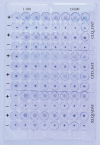Are We Now Well Prepared for Another Major Visceral Leishmaniasis Epidemic in Sudan?
- PMID: 31660326
- PMCID: PMC6778318
- DOI: 10.1093/ofid/ofz226
Are We Now Well Prepared for Another Major Visceral Leishmaniasis Epidemic in Sudan?
Abstract
To minimize the chance for future visceral leishmaniasis (VL) epidemics such as the 1988-1991 epidemic in Sudan, several VL detection tools have been introduced. There are many VL diagnostics with excellent sensitivities, specificities, and ease of use reported. However, additional test characteristics should be considered for use in the detection of future VL epidemics. The potential for local production or uninterrupted availability, low production and application costs, and stability at ≥45°C are of the utmost importance. Of the antibody-, antigen-, or DNA-based methods introduced, only a liquid direct agglutination test (LQ-DAT) remains in routine use. The LQ-DAT test may be the ideal diagnostic for detection of VL epidemics due to its low cost ($0.50/patient), stability under frequent and long-duration electric failures, and high level of reproducibility. The improved reliability for VL detection achieved locally through incorporating autochthonous L. donovani strains in antigen processing and precluding toxicants in test execution provides optimal sensitivity and safety for routine and mass application.
Keywords: antibody; antigen; diagnosis; epidemic; visceral leishmaniasis.
© The Author(s) 2019. Published by Oxford University Press on behalf of Infectious Diseases Society of America.
Figures

References
-
- Stephenson RW. An epidemic of kala‐azar in the Upper-Nile province of the Anglo‐Egyptian Sudan. Ann Trop Med Parasitol 1940; 34:175–9.
-
- Sati MH. Early phases of an outbreak of kala‐azar in the Southern Fung. Sud Med J 1958; 1:98–111.
-
- de Beer P, el Harith A, van Grootheest M, Winkler A. Outbreak of kala-azar in the Sudan. Lancet 1990; 335:224. - PubMed
-
- de Beer P, el Harith A, Deng LL, et al. . A killing disease epidemic among displaced Sudanese population identified as visceral leishmaniasis. Am J Trop Med Hyg 1991; 44:283–9. - PubMed
-
- Seaman J, Mercer AJ, Sondorp E. The epidemic of visceral leishmaniasis in western Upper Nile, Southern Sudan: course and impact from 1984 to 1994. Int J Epidemiol 1996; 25:862–71. - PubMed

